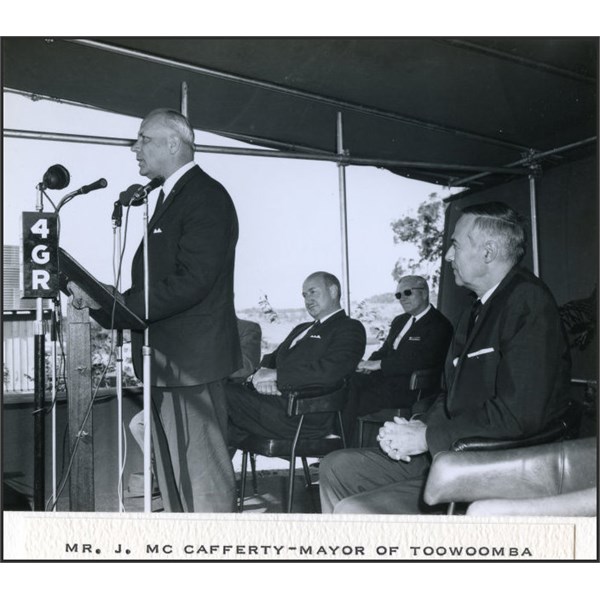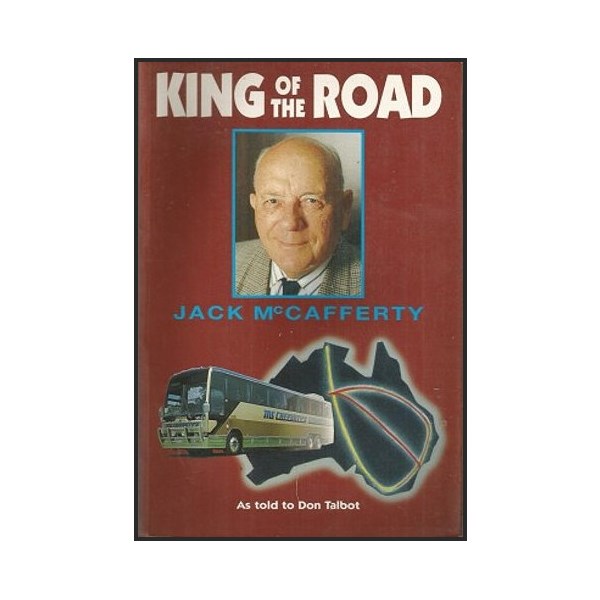McCafferty's Coaches was formed in April 1940 when Jack McCafferty began a service from Picnic Point to Rangeville in
Toowoomba. In 1955 McCafferty's began operating a service from
Toowoomba to the
Gold Coast. Over the next few decades McCafferty's expanded to operate long distance
services throughout Queensland.

In Greyhound's Noosa depot in August 2009 was this beautifully restored Bedford OB lettered for McCafferty's Bus Service of Toowoomba
In December 1980 McCafferty's entered the interstate coach market with a
Brisbane to
Sydney service extending to
Melbourne in December 1983. In November 1992 McCafferty's commenced operating
Melbourne to
Adelaide and
Adelaide to
Darwin services followed by
Sydney -
Canberra -
Adelaide in late 1993 and
Darwin -
Broome -
Perth in May 1995 making it a national operator. The latter service was withdrawn in June 1996.
The
Brisbane to
Charleville service was acquired from Skennars in 1992. In 1999 McCafferty's purchased MotorCoach Australia from the administrator of Clifford Corporation. As
well as building coaches for McCafferty's it also completed orders for external customers. It closed in 2004 having completed over 60 coaches.

334 ex Trans City

Denning Landseer 307 seen in Darwin
In March 2000 McCafferty's entered into negotiations with Greyhound Pioneer Australia about a possible merge. In September 2000 a takeover bid from McCafferty's for Greyhound was accepted. As part of the deal the McCafferty family sold their shares to Tony McCafferty. In October 2004 the McCafferty family sold its shares to ANZ Bank and George Chapman, and both operations were rebranded as Greyhound Australia.
From the late 1960s, McCafferty's purchased exclusively new Denning coaches. In the first half of the 1990s, 40 second-hand Denning Landseers from a variety operators were purchased for its interstate expansion. From 1994 it began purchasing MotorCoach Australia coaches.
In the 1970s McCafferty's coaches were painted in a white with blue and black, then into the early 1980s, a magenta and blue livery appeared. In 1987 a silver,
grey, blue and red livery was introduced followed by a two-tone gold and blue livery, originally intended as a special livery to mark the company's 50th anniversary in 1990, but adopted as standard. The final livery was a sand-like "Platinum" with blue colour scheme to celebrate the company's 60th anniversary.

The Mayor of Toowoomba, Mr Jack McCafferty
Before the decision to market the entire McCafferty-Greyhound business under the Greyhound Australia branding, the McCafferty division was getting more flamboyant with its livery application, almost harking back to the rocket days at its formation. This elaborately decorated MCA Marathon High Deck, 461 (60MCC), below seen at Noosa in July 2004, was unique in the fleet.

MCA Marathon High Deck, 461 (60MCC), at Noosa in July 2004,
Clybucca, December 22, 1989 two full tourist coaches collided head-on in the early morning at Clybucca Flat, 12km north of Kempsey, at an estimated combined speed of 200 km/h. The coaches concertinaed into each other, killing both drivers instantly. The force of the impact left the McCafferty’s
Sydney-bound coach in the cabin of the TransCity
Brisbane-bound coach. The
Sydney coach was forced five rows back into the other.

The scene of Australia worst road crash
A fleet of air ambulances and helicopters carried the injured to hospitals at Kempsey, Port Macquarie,
Coffs Harbour and
Sydney. A NSW Coroner’s inquiry into the coach collision found that the McCafferty driver fell asleep at the wheel. The driver failed to negotiate a left-hand bend on the highway and the coach crossed to the wrong side and collided with the TransCity coach.
Jack McCafferty was born at
Breakfast Creek,
Brisbane on 11 March 1914, During the depression in the 1930s, Jack operated a milk run with a horse and cart in Wilsonton.
On 1 April 1940, Jack began his first bus run, the Picnic Point to Rangeville service. Later in 1950, he acquired a co-ordinated bus-rail link from
Toowoomba to
Brisbane. Over the following years, Jack acquired further
services, building the McCafferty's Coaches business into an Australia-wide coach service.
In 1955, Jack was elected as an Alderman to the
Toowoomba City Council and within three years he was the 58th Mayor of
Toowoomba, an office he held for nine years until his defeat in 1967. During this time, he came to be regarded as a dynamic Mayor who put
Toowoomba on the map.

King of the Road - Jack Mccafferty

Headstone
Jack McCafferty died on 12 January 1999 at the age of 84 after a 2-year battle with cancer. His funeral was held at St Patrick's Cathedral and was attended by more than 1,000 people.